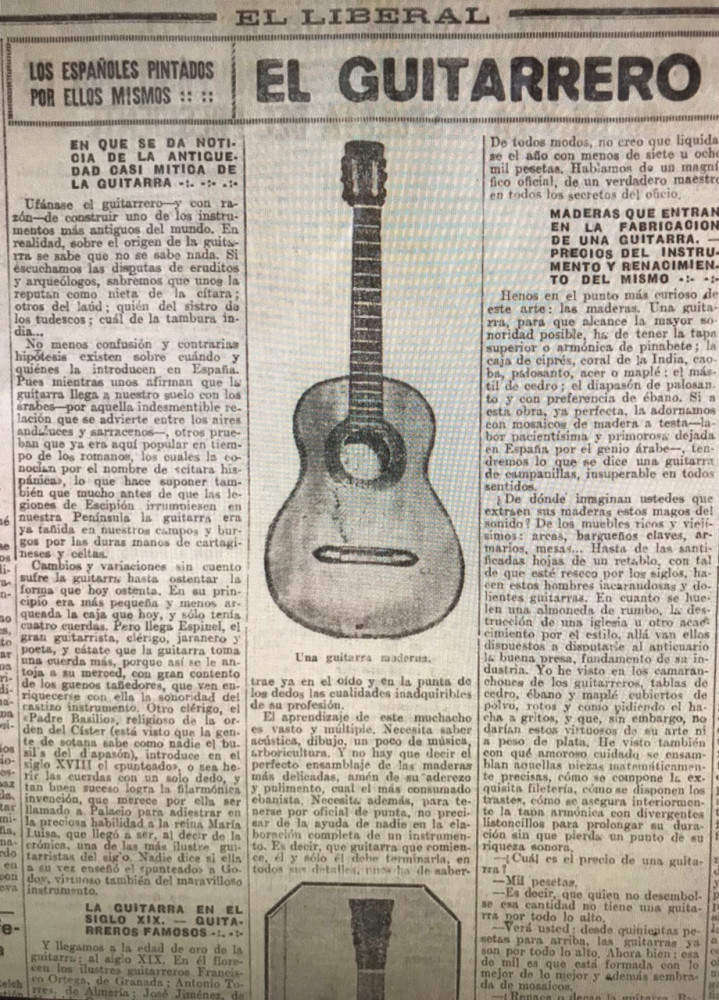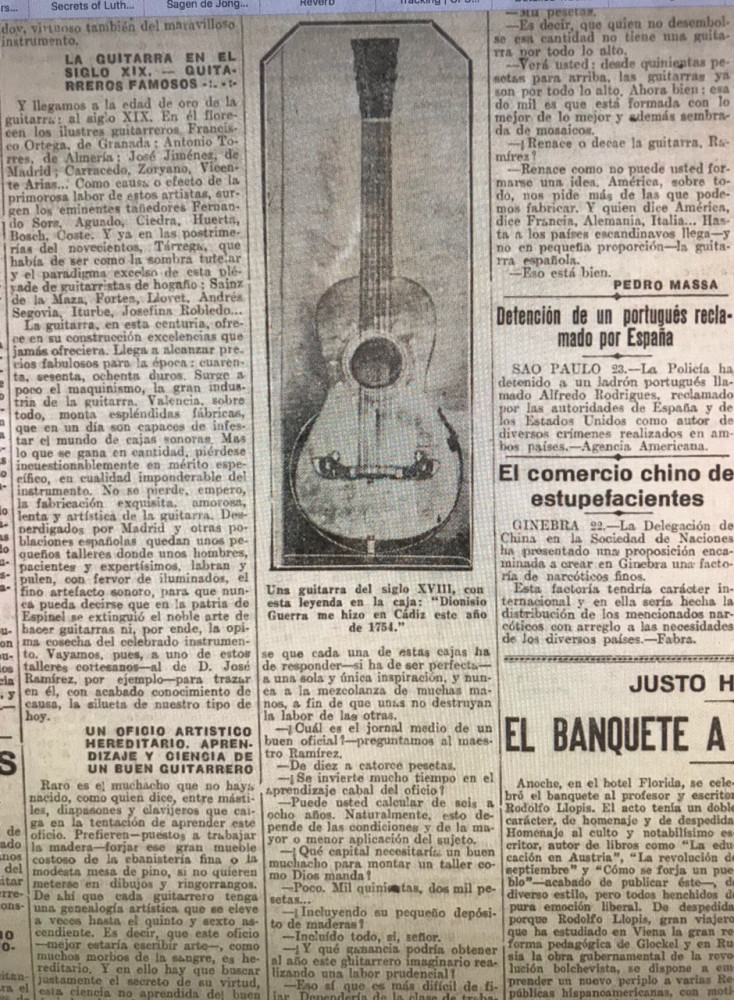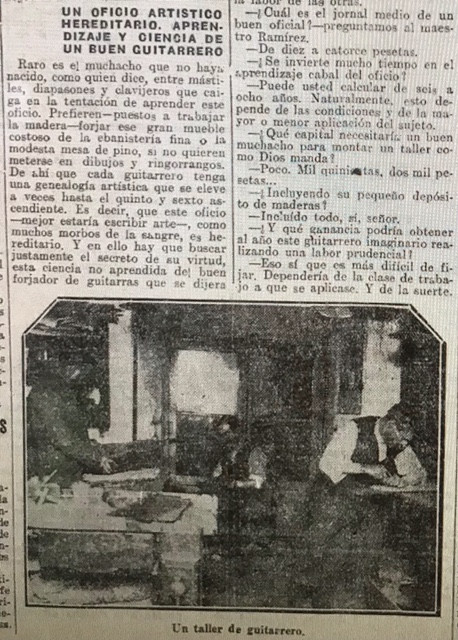1930 Jose Ramirez II (1885-1957) Interview
Jose Ramirez II Interview
The literal interview is found below this extrapolation. This is from the newspaper: "El Liberal" (founded in Madrid in 1879). January 23, 1930, page 3. This is an article and interview by Pedro Massa (Cieza, Spain 1895- Buenos Aires, 1987). This article was found in the Biblioteca Nacional de España, Madrid.
This interview was published less than 90 days after the Stock Market Crash of October 1929. Andres Segovia had just finished his tour of Asia using his 1912 Manuel Ramirez and Hermann Hauser I guitars: performing in Hong Kong, The Philippines, China and Japan. When Andres Segovia was performing in Japan in late October, early November of 1929, Regino Sainz de la Maza and Miguel Llobet were both playing in theaters in Buenos Aires at the same time. The day to day details can be found in my book: Annotations for the History of the Classical Guitar in Argentina 1822-2000, 4 Vols. Authors: Randy Osborne, Héctor García Martínez | Index by Jan J. de Kloe. This book can be ordered at the bottom of the homepage of this web site.
The writer, Pedro Massa, makes note of the illustrious guitar makers of the 19th century:
Francisco Ortega of Granada
Antonio de Torres of Almeria
Jose Jimenez of Madrid
Enrique Carracedo of Madrid
Mariano Zorzano of Logrono, though in Madrid from 1879.
Vicente Arias of Madrid.
He mentions some of the 19th century's premier guitarists / composers: Sor, Aguado, Ciebra, Huerta, Bosch, Coste.
He says Francisco Tarrega taught or if not gave a shadow to: Sainz de la Maza, Fortea, Llobet, Andres Segovia, Iturbe, Josefina Robledo..... (three of this group were already international concert and recording artists: Regino Sainz de la Maza, Miguel Llobet and Andres Segovia.)
At the end of the interview he says: "We are getting more orders from South America than we can fill, besides those orders we're receiving from France, Germany, Italy....., all the way to the Scandinavian countries, and not in small amounts either, all for the Spanish Guitar."
Agustin Barrios used a Jose Ramirez concert guitar to record his works in the few 1910 recordings for Edison Cylinders, and later in his most well known Discos Atlanta 1913-1914 sessions.
In Madrid, the Jose Ramirez workshop, has produced well over 25,000 Model 1-A Classical and Flamenco Guitars, utilized by Andres Segovia and countless other virtuosos to perform concerts and make the eternal recordings.
The guitar termed: 1754 Dionisio Guerra (1755-), made in Cadiz, Spain fabricated around 1785, had been a part of the Jose Ramirez Guitar Collection for many decades, and is displayed with its specifications in the book by Brian Whitehouse "The Ramirez Collection" published in 2009.
Here is the complete interview:
The Guitar Maker - The Spanish painted by themselves.
The guitar maker - boasts - with reason - to construct one of the oldest instruments in the world. In reality, about the origin of the guitar, its known that he knows nothing. If we listen to the disagreements of the erudite and the archaeologists, we will know that some of the reputed ones as a granddaughter of the citara; others the lute, which is of the cistern of the Germans; which is of the Indian tambura...
It's not any less confusing and a contrary hypothesis exists about when and who introduced it in Spain. Well meanwhile some affirm that the guitar arrived to our soil with the arabs - by that undeniable relation warns among the Andalucian and Saracens airs - others prove it was already popular here in Roman times, which know it by the name "Hispanic zither", which makes one also suppose that much earlier than when the legions of the Egyptians disrupted our peninsula that the guitar was already strummed in our fields and cities by the hard hands of the Carthaginians and Celts.
The guitar suffered uncountable changes and variations until it showed that which it bestows today. In its beginning it was much smaller and the body less arched than today, and only had four strings. But Espinel came, the great guitarist, the clergyman, the reveler and the poet who knew the guitar needed to add one string, because that's how it seems to his mercy, with great contentment the strummers let us know, that they saw the traditional instrument enriched with sonority. Another clergyman, Padre Basilio, religious of the order of the Cister (seen by the people as someone who knew the fretboard like no other) introduces in the 18th century the plucking of solo notes with such a success he was called to the Royal Court to show his precious ability to Queen Maria Luisa, who came to be, that is to say the chronicler of, one of the most illustrious guitarists of the century. Nobody says if she in turn taught Godoy (also a virtuoso of the marvelous instrument) the manner of plucking.
The Guitar in the 19th Century - Famous Guitar makers -
And we arrive at the Golden Age of the Guitar; the 19th Century. Flowering in it were the illustrious guitar makers.
Francisco Ortega of Granada
Antonio de Torres of Almeria
Jose Jimenez of Madrid
Enrique Carracedo of Madrid (sic) Antonio Carracedo
Mariano Zorzano of Logrono, though in Madrid from 1879.
Vicente Arias of Madrid.
As a cause or effect of the exquisite labor of these artists the eminent players surged out:
Fernando Sor,
Aguado,
Ciebra,
Huerta,
Bosch,
Coste.
And in the end times of the 19th Century, Francisco Tarrega taught or if not gave an educational shadow to:
Sainz de la Maza,
Fortea,
Llobet,
Andres Segovia,
Iturbe,
Josefina Robledo.
The guitar, in that century, offers in its excellent construction what it never offered before. It came to reach fabulous prices of the epoch; forty, sixty, eighty duros. The use of machines surged a little, the great industry of the guitar. Valencia, overall, splendid workshops were mounted up, that in a day its capacity to infest the world of sonorous musical bodies. More than what it gains in its quantity, it loses in its unquestionable specific merit, in the imponderable quality of the instrument. It doesn't lose, however, the loving, slow and artistic exquisite fabrication of a guitar. Scattered in Madrid and other Spanish towns, remain small workshops where some men, patient and so expert make and polish, with the illuminated fervor, the fine sonorous artefact, so that it can never be said that in the homeland of Espinel the noble art to make guitars or for that matter, the opium of the celebrated instrument. Let's go, then, to one of those courtly workshops - to that of Jose Ramirez, for example, to trace in it, with a finished knowledge of cause, of the silhouette of today's type.
A hereditary artistic trade. Apprenticeship and science of a good guitar maker.
Rare is the young guy that hasn't been born, as they say, among necks, fret boards and tuning machines who doesn't fall into the temptation to learn this trade. They prefer - to be put to work the wood - forge that great expensive piece of fine cabinetry or the modest pine table if they don't want to be involved in sketches and frills. From there what every guitar maker who might have an artistic genealogy who was raised as a 5th or 6th generation descendant. That is to say, that this trade - it would be better to write art - like many morbid blood, is hereditary. And in it you have to justly search the secret of its virtue, this science isn't learned by good forgers of guitars what was said brings in the ear already in the fingertips the unobtainable qualities of his profession.
The apprenticeship of this young guy is vast and multiple. You need to know acoustics, drawing, a little of music, arboriculture. And that isn't to say the perfect assembly of the most delicate woods, amen to its dressing and polishing like the consummate cabinetmaker. Besides you need, to be considered a leading officer, to not need any help of anyone in the complete elaboration of an instrument. It is to say, a guitar begins, it an only it must be finished, in all its details, some have to know that each of these bodies have to responder - if it is to be perfect - to be one and only unique inspiration, and never a hodgepodge of many hands, at the end of which some don't destroy the labor of others.
"What is the average daily salary of a good journeyman?" we ask to maestro Ramirez.
"Between 10 ($1.50) and 14 ($2.00) pesetas"
"You invest a lot of time in the exact apprenticeship of a journeyman?"
"You can calculate between 6 and 8 years. Naturally, that depends on the abilities best and least application of the subject."
"How much money is necessary for a good young man to set up a workshop as God intended?"
"Little. 1,500, 2,000 pesetas."
"Including a small warehouse of woods?"
"Including everything, yes, Sir."
"And what profit can be obtained by this imaginary guitar maker for prudential labor a year?"
"That is the most difficult to figure out. It would depend on the level of work to which it is applied. And of the luck. Anyways, I don't believe I'd see less than 7,000 to 8,000 pesetas. We're talking about a magnificent journeyman, a real master of the secrets of the trade"
Woods that are involved in the fabrication of the guitar. - Prices of the instrument and renaissance of the same. -
We are in the most curious point of this art: the woods. A guitar, to achieve the best sonority possible, has to have the superior harmonic soundboard of Spruce; the body of Cypress, Paduk of India, Cuban Mahogany, Rosewood, Maple; the neck of Cedar; the fret board of Rosewood or if you prefer of Ebony. If this work, is already perfect, the adornments with mosaics of wood - the most patient and exquisite left in Spain by the genius Arab - we will have one can say a guitar of the sound of church bells, unsurpassable in all senses.
Where do you imagine the woods are extracted from, by these magicians of sound? From the oldest rich furniture, arks, key jars, cabinets, tables. All the way to sanctified leaves of an altarpiece, with which parched by the centuries, make those men's Brazilian Rosewood mourner's guitars. As soon as they smell a sale on the way, the destruction of a church or another occurrence by the style, there they go, ready to dispute the antiquarian for the good prize, the foundation of their industry. I have seen in the lofts of the guitar makers, Cedar, Ebony and Maple tables covered in dust, broken and as asking the screaming ax, and that, however, they won't give the virtuosos of their art not even a peso of silver. I have also seen with what loving care they assemble those pieces mathematically precise, how the exquisite fileteria is composed, how the frets are arranged, how the interior of the harmonic soundboard is secured with divergent pieces to prolong its duration without losing a point of its rich sonority.
"What is the price of a guitar?"
"1,000 pesetas."
"That is to say, that whoever does not pay that amount does not have a guitar in style."
"You will see, from 500 pesetas and up, they are all over the top. Now well: that two thousand is that it is made up of the best of the best and also strewn with mosaics."
" Is the guitar being reborn or decaying, Ramirez?"
"Being reborn as you can't form an idea. South America, overall, asks us for more than we can fabricate. And who says South America, France says, Germany, Italy....All the way to the Scandinavian countries come - and in no small amount - the Spanish Guitar."
-- "That's ok."
Pedro Massa


